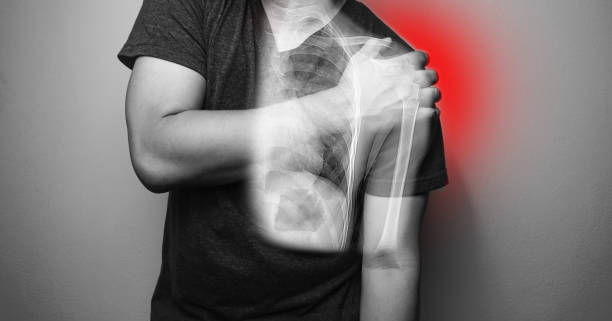Shoulder dislocation can result from a range of activities, accidents, falls, or sports injuries. When your upper arm bone (humerus head) comes out of its socket (glenoid), it can damage the surrounding shoulder tissue, leading to significant pain and other issues. It’s crucial to reach out to a doctor promptly for proper treatment. In this blog, we will discuss the types, causes, symptoms, diagnosis, treatment, and ways to prevent shoulder dislocations. Let’s dive in!
Types of Shoulder Dislocation
Shoulder dislocations fall into three main categories, depending on the direction the upper arm bone (humerus) moves away from the socket joint after dislocation:
Anterior (Forward) Dislocation:
- Most common type, making up over 95% of shoulder dislocation cases.
- It typically results from an indirect force involving a combination of arm abduction, extension, and external rotation.
- Anterior dislocation is frequently linked to injuries such as Labrum tears, significant tuberosity fractures, and humeral head fractures.
Posterior (Backwards) Dislocation:
- Occurs when the humerus bone separates and moves away from the socket joint.
- This type constitutes 2% to 4% of all shoulder dislocations.
- Causes include seizures, electrical shocks, falling on an outstretched arm, or experiencing a blow to the front of the shoulder.
Inferior Dislocation:
- The rarest type occurs in approximately 1 in every 200 cases.
- Happens when the humerus is violently pushed downward.
Shoulder dislocations are usually a result of trauma, but in rare cases, they can occur with simple shoulder motions. These motions may be more likely to cause dislocations in individuals with weakened ligaments due to an inherent condition, potentially increasing the risk of dislocations in other joints.
It’s noteworthy that shoulder dislocations are the most common type of joint dislocations, primarily affecting young male adults and older women. This prevalence is because our upper extremities are extensively used in our daily activities, making shoulder joints more susceptible to dislocations compared to lower extremities.
Causes of Shoulder Dislocation
Shoulder dislocations can happen due to various reasons, especially during activities that involve intense force, twisting, or direct impact on the shoulder joint. Here are some common causes:
Forced Injury: A powerful blow to the shoulder or a sudden fall onto an outstretched arm can result in a shoulder dislocation. If the shoulder joint is twisted excessively, the ball of the upper arm bone may pop out of its socket.
Sports-related injury: Shoulder dislocation is a risk in contact sports such as football, rugby, and wrestling, as well as in sports like basketball and skiing.
Weak ligaments or tendon sprains: Individuals with weak or loose ligaments are more susceptible to shoulder dislocation because their joints lack the necessary stability.
Shoulder Dislocation Symptoms
Recognizing a shoulder dislocation involves observing several key signs:
Severe Pain: Movement intensifies the pain, and you may find it challenging to move your arm or experience complete immobility.
Inflammation and Bruising: Swelling and bruising around the shoulder joint are common indicators of a dislocation.
Deformed Appearance: The shoulder may look visibly out of place or deformed.
In addition to these, you might also experience numbness, tingling, or weakness near the injury. If you notice these shoulder dislocation symptoms, it’s crucial to seek immediate medical attention. While waiting for professional help, refrain from trying to relocate the shoulder yourself, as this could potentially harm nearby blood vessels, nerves, muscles, and ligaments. Using ice packs can help alleviate pain and reduce swelling.
Diagnosing Shoulder Dislocation
If you suspect any shoulder dislocation symptoms, it’s crucial to seek immediate medical attention. A healthcare professional will conduct a thorough assessment, which typically involves:
Physical Examination: The doctor will visually inspect the shoulder, assess its mobility, and inquire about your comfort level.
Imaging Tests: To identify injuries such as fractures or sprains, the medical expert may recommend X-rays, CT scans, or MRI tests.
Getting prompt medical help is essential for an accurate diagnosis and appropriate treatment.
Shoulder Dislocation Treatment
Addressing a shoulder dislocation involves various approaches:
Closed Reduction: A medical professional will gently maneuver the upper arm bone back into the shoulder socket. Sedation or anesthesia may be used for pain relief and muscle relaxation during this process.
Immobilization: After reduction, the shoulder may be immobilized for several weeks using a sling or brace. This helps promote healing and prevents further dislocations.
Surgery: For individuals with persistent instability or multiple dislocations, surgery may be recommended. Modern shoulder dislocation surgery is considered safe and effective, reducing the risk of re-injury, especially in young athletes.
Medication: Pain relievers and muscle relaxants will be prescribed to enhance comfort during the healing process.
Rehabilitation: After the immobilization period, comprehensive rehabilitation is essential. This involves exercises and physical therapy to restore strength, stability, and range of motion in the shoulder joint.
Preventing Shoulder Dislocations
Although some shoulder dislocations may be unavoidable, taking certain precautions can help minimize the risk:
Muscle Strengthening Exercises: Engage in exercises that strengthen shoulder muscles to improve stability and reduce the chances of dislocation.
Proper Equipment: When participating in activities or sports with intense physical contact, use appropriate gear such as shoulder pads or braces to provide added protection.
Correct Techniques: Whether exercising, playing sports, or lifting heavy weights, use proper techniques to minimize the risk of shoulder injury. It’s also essential to warm up before engaging in these activities.
Important Points to Remember
Shoulder dislocation is a painful condition that can significantly impact daily life and physical activity. Quick diagnosis and effective treatment are crucial for promoting healing and preventing repeated dislocations. To maintain the health of your shoulder joints, it’s important to be aware of the causes, shoulder dislocation symptoms, diagnosis, treatment, and preventive measures related to shoulder dislocation. If you suspect a shoulder dislocation, seek immediate medical care. Book your appointment today!






